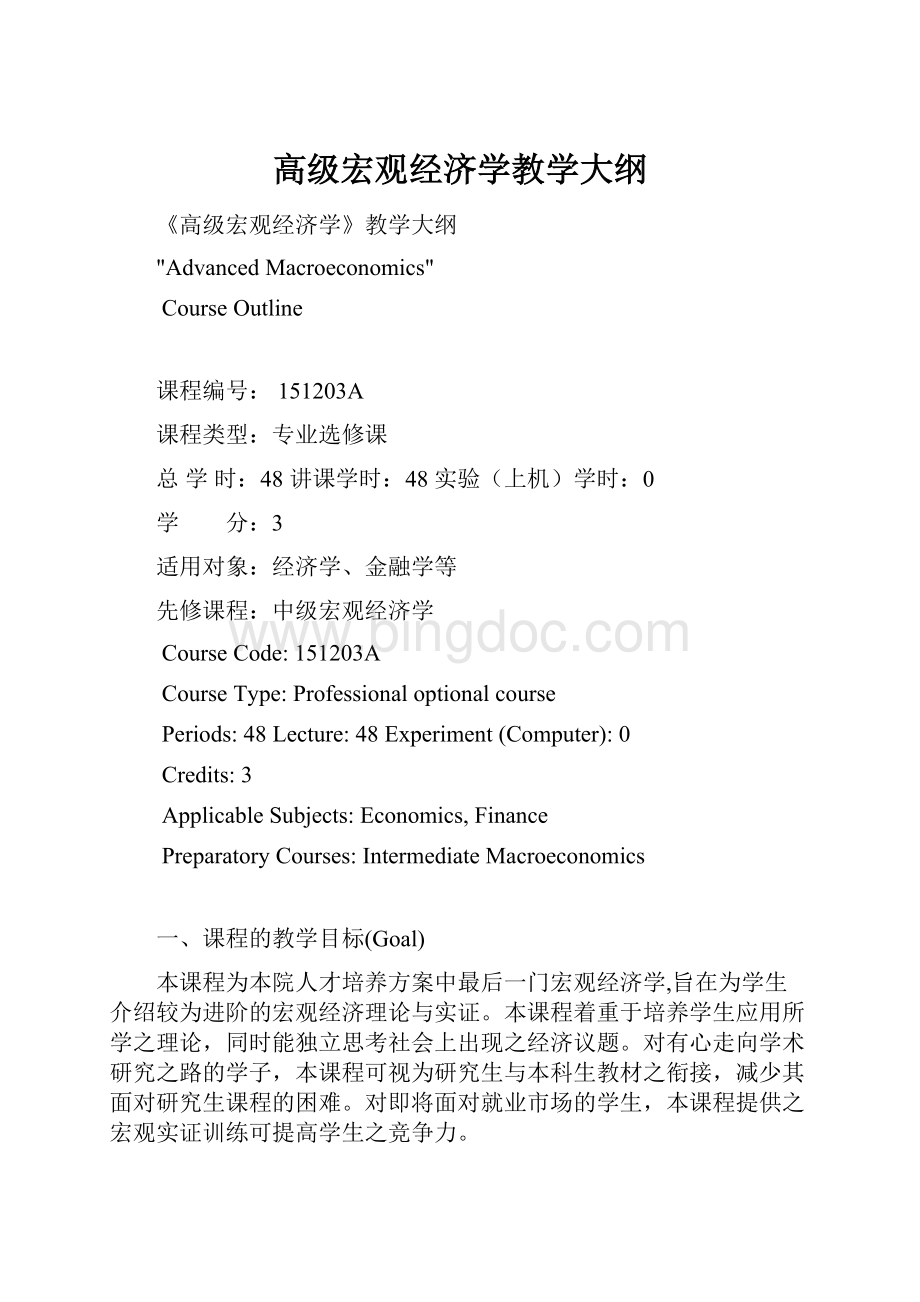高级宏观经济学教学大纲.docx
《高级宏观经济学教学大纲.docx》由会员分享,可在线阅读,更多相关《高级宏观经济学教学大纲.docx(10页珍藏版)》请在冰点文库上搜索。

高级宏观经济学教学大纲
《高级宏观经济学》教学大纲
"AdvancedMacroeconomics"
CourseOutline
课程编号:
151203A
课程类型:
专业选修课
总学时:
48讲课学时:
48实验(上机)学时:
0
学 分:
3
适用对象:
经济学、金融学等
先修课程:
中级宏观经济学
CourseCode:
151203A
CourseType:
Professionaloptionalcourse
Periods:
48Lecture:
48Experiment(Computer):
0
Credits:
3
ApplicableSubjects:
Economics,Finance
PreparatoryCourses:
IntermediateMacroeconomics
一、课程的教学目标(Goal)
本课程为本院人才培养方案中最后一门宏观经济学,旨在为学生介绍较为进阶的宏观经济理论与实证。
本课程着重于培养学生应用所学之理论,同时能独立思考社会上出现之经济议题。
对有心走向学术研究之路的学子,本课程可视为研究生与本科生教材之衔接,减少其面对研究生课程的困难。
对即将面对就业市场的学生,本课程提供之宏观实证训练可提高学生之竞争力。
AsthelastmacroeconomicscourseofferedintheISEMprogram,themaingoalofthiscourseistointroducerelativelyadvancedmacroeconomictheoriesandempiricalstudies.Inthiscourse,studentswillacquiretheabilitytoapplythetheoriestobelearnedandtoanalyzeindependentlyeconomicissuesraisedinoursociety.Forstudentswhoareintendedtopursueadvancedacademicdegrees,thiscoursecanhelpthembridgethegapbetweengraduateandundergraduatecurriculumandreducethedifficultieswhichmayconfronttheminagraduateprogram.Thosewhowilljointhejobmarketupontheirgraduationwillfindthiscoursehelpfulinincreasingtheircompetitivenessbyacquiringtheempiricalmacroeconomicstechniques.
二、教学基本要求(Teachingrequirements)
本课程强调理论与实证并重,在讲解基本的理论后,授课老师应介绍相对应的实证研究或后续发展。
譬如讨论货币政策的议题,授课老师应详细讲解传统理论中货币政策之效果,并介绍实证上如何评估,以及后续货币政策理论之发展。
然而授课老师必须考量学生对高级经济学理论技术之掌握,不应过快且过多的讲解学生无法吸收的理论技术。
因此,本课程之授课老师应着重讲解每个环节中之经济学思路,以及实证研究之逻辑。
对于要求学生阅读之学术文章,应提供具体的问题让学生知道他们阅读的重点。
本课程之考核方式建议采用比闭卷考试以及期末报告。
考试可占70%,平时与报告占30%。
Thiscourseemphasizesequallyontheoreticalandempiricalmacroeconomics.Afterintroducingbasictheories,theinstructorshouldfurtherintroducecorrespondingempiricalstudiesandsubsequentdevelopments.Forexample,onissuesofmonetarypolicies,theinstructorshouldfirstthoroughlyintroducetheeffectsofconventionalmonetarypolicyintraditionalmacromodels,thendiscusshowtoaccesstheseeffectsempirically,andbroadlytalkaboutsubsequentstudiesofmonetarypolicy.However,theinstructorshouldconsiderstudents'familiaritywithadvancedtechniquesoftheoreticaleconomicsandshouldnotintroducetoomuchtechniquesthatstudentscouldnotdigest.Therefore,emphasisshouldbeplacedondiscussingtheeconomicthinkingbehindeverytheoryandthereasoningofanempiricalstudy.Foracademicarticlesstudentsareassignedtoread,theinstructorshouldprovidespecificreviewingquestionssothatstudentswillknowthemainpoints.Thesuggestedevaluationforthiscourseconsistsoftwoclosed-bookexamsandapresentation.Examstake70%andpresentation/assignmentstaketherest30%.
三、各教学环节学时分配
教学课时分配(ClassSchedule)
序号
章节内容
讲课
实验
其他
合计
1
宏观经济数据与分析
Macroeconomicdataanalysis
3
0
0
0
2
AD-AS模型
AD-ASmodels
9
0
0
0
3
宏观经济政策与国际资产流动
Macroeconomicpolicyandinternationalcapitalmobility
12
0
0
0
4
消费与投资
Consumptionandinvestment
6
0
0
0
5
金融市场与经济周期
FinancialMarketandbusinesscycle
3
0
0
0
6
长期经济增长理论与实证
Long-runeconomicgrowththeoriesandempiricalevidence
15
0
0
0
合计
48
0
0
0
四、教学内容(黑体,小四号字)
第一章宏观经济数据与分析
第一节宏观经济数据
1.国内生产毛额
2.物价指数
3.失业率
4.利率与汇率
第二节经济数据分析
1.如何计算成长率
2.如何计算折现值
教学重点、难点:
宏观经济变量的特性,常用的经济数据分析方法。
课程的考核要求:
了解宏观经济变量的特性,掌握经济数据分析方法与计算。
Chapter1Macroeconomicdataanalysis
Section1Macroeconomicdata
1.Grossdomesticproduct
2.Pricesindices
3.Unemploymentrate
4.Interestrateandexchangerates
Section2Toolsfordataanalysis
1.Howtocalculategrowthrate
2.Howtocalculatepresentvalue
KeyandDifficultPoints:
Featuresofmacroeconomicdata,toolsforanalyzingmacroeconomicdata.
EvaluationRequirements:
Understandfeaturesofmacroeconomicdata;acquiretoolsforanalyzingmacroeconomicdata.
第二章AD-AS模型
第一节静态AD-AS模型
1.AS曲线
2.AD曲线
3.AD-AS模型与应用
第二节动态AD-AS模型
1.AS曲线与飞利浦曲线之关系
2.动态AD曲线
3.动态AD-AS模型与应用
教学重点、难点:
AD与AS的经济理论以及其应用。
静态模型到动态模型的转换。
课程的考核要求:
理解AD与AS的经济理论,熟悉其应有。
理解静态模型到动态模型的转换。
Chapter2AD-ASmodels
Section1StaticAD-ASmodel
1.AScurve
2.ADcurve
3.Applications
Section2DynamicAD-ASmodel
1.FromAScurvetoPhillipscurve
2.DynamicADcurve
3.Applications
KeyandDifficultPoints:
TheoreticalbasisandapplicationsofAD-ASmodel.Transitionfromstatictodynamicmodel.
EvaluationRequirements:
UnderstandtheoreticalbasisofAD-ASmodel;getfamiliarwithapplications;understandtransitionfromstatictodynamicmodel.
第三章宏观经济政策与国际资产流动
第一节IS-LM模型
1.商品市场均衡
2.货币市场均衡
3.IS-LM模型与应用
第二节货币与财政政策
1.货币政策
2.财政政策
第三节国际资产流动与IS-LM模型
1.国际收支与汇率
2.汇率的长期均衡
3.资产流动
4.Mundell-Fleming模型与应用
教学重点、难点:
IS-LM模型的理论基础;货币与财政政策的效果;开放经济体的宏观经济政策。
课程的考核要求:
理解IS-LM模型的理论基础;熟悉分析货币与财政政策的效果;理解与分析开放经济体的宏观经济政策。
Chapter3Macroeconomicpoliciesandinternationalcapitalmobility
Section1IS-LMmodel
1.Equilibriumingoodsmarket
2.Equilibriuminmoneymarket
3.IS-LMmodelsanditsapplications
Section2Monetaryandfiscalpolicy
1.Monetarypolicy
2.Fiscalpolicy
Section3InternationalcapitalmobilityandIS-LMmodel
1.Balanceofpaymentsandexchangerate
2.Long-runequilibriumexchangerate
3.Capitalmobility
4.Mundell-Flemingmodelanditsapplications
KeyandDifficultPoints:
TheoreticalbasisandapplicationsofIS-LMmodel;effectsofmonetaryandfiscalpolicy;macroeconomicpoliciesinopeneconomy.
EvaluationRequirements:
UnderstandtheoreticalbasisofIS-LMmodel;getfamiliarwithanalyzingeffectsofmonetaryandfiscalpolicy;understandandanalyzemacroeconomicpoliciesinopeneconomy.
第四章消费与投资
第一节消费与储蓄
1.生命周期与恒久性收入理论
2.不确定下的消费决策
第二节投资支出
1.资本存量与投资流量
2.固定投资、住宅投资与存货
3.投资与总供给
教学重点、难点:
消费行为的理论基础;投资行为的理论基础。
课程的考核要求:
理解消费与投资行为的理论基础
Chapter4Consumptionandinvestment
Section1Consumptionandsaving
1.Life-cycleandpermanentincometheory
2.Consumptiondecisionunderuncertainty
Section2Investment
1.Capitalstockandinvestmentflow
2.Fixedinvestment,residentialinvestment,andinventory
3.Investmentandaggregatesupply
KeyandDifficultPoints:
Theoreticalbasisofconsumptionandinvestmentbehaviors.
EvaluationRequirements:
Understandtheoreticalbasisofconsumptionandinvestmentbehaviors.
第五章金融市场与资产价格
第一节长期利率与短期利率
第二节股价与随机漫步理论
第三节汇率与利率
教学重点、难点:
利率期限结构;随机漫步理论;汇率与利率之关系。
课程的考核要求:
理解利率期限结构;理解随机漫步理论;分析汇率与利率之关系。
Chapter4Financialmarketandassetprices
Section1Long-termandshort-terminterestrates
Section2Stockpriceandrandomwalktheory
Section3Exchangerateandinterestrate
KeyandDifficultPoints:
Termstructureofinterestrate;randomwalktheory;connectionbetweenexchangerateandinterestrate.
EvaluationRequirements:
Understandtermstructureofinterestrate;understandrandomwalktheory;knowhowtoanalyzeconnectionbetweenexchangerateandinterestrate.
第六章经济增长理论与实证
第一节经济增长与累积
1.增长会计法
2.增长的实证估计
3.新古典增长理论
第二节经济增长与政策
1.内生增长理论
2.经济增长政策
教学重点、难点:
增长会计法;新古典增长理论;内生增长理论。
课程的考核要求:
理解与应用增长会计法;理解新古典与内生增长理论;熟悉增长理论建议的经济增长政策。
Chapter6Economicgrowththeoriesandempiricalevidence
Section1Economicgrowthandaccumulation
1.Growthaccounting
2.Empiricalestimatesofeconomicgrowth
3.Neo-classicaleconomicgrowththeory
Section2Economicgrowthandpolicies
4.Endogenousgrowththeory
5.Economicgrowthpolicies
KeyandDifficultPoints:
Growthaccounting;neo-classicaleconomicgrowththeory;endogenousgrowththeory.
EvaluationRequirements:
Understandandapplygrowthaccounting;understandneo-classicalandendogenousgrowththeory;getfamiliarwitheconomicpoliciessuggestedbyeconomicgrowththeories.
五、其它
本课程之评分方式可由授课老师调整,课时分配可依授课老师之专长及学生之兴趣略做调整。
Courseevaluationcanbeadjustedbytheinstructor.Classschedulecanbeflexibleaccordingtotheinstructor'sexpertiseandstudents'interests.
六、主要参考书
列出主要参考书目,所列条目及其顺序如下:
[1]RudigerDornbusch,StanleyFischer,andRichardStartz.Macroeconomics,12thedition.USA.McGraw-HillEducation.2013.10.1
[2]N.GregoryMankiw.Macroeconomics,8thedition.USA.WorthPub.2012.6.1.